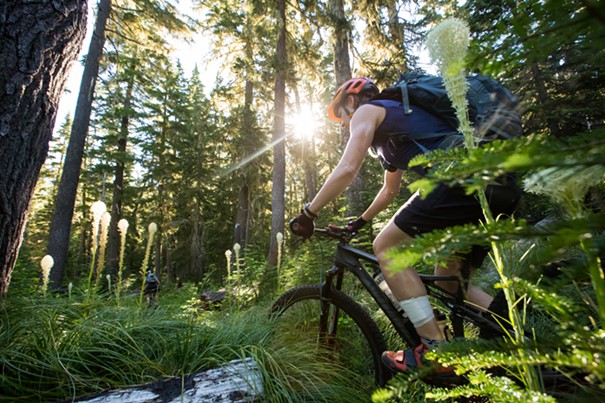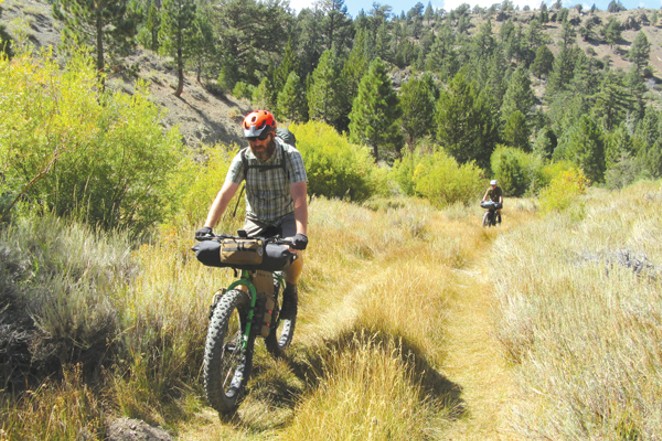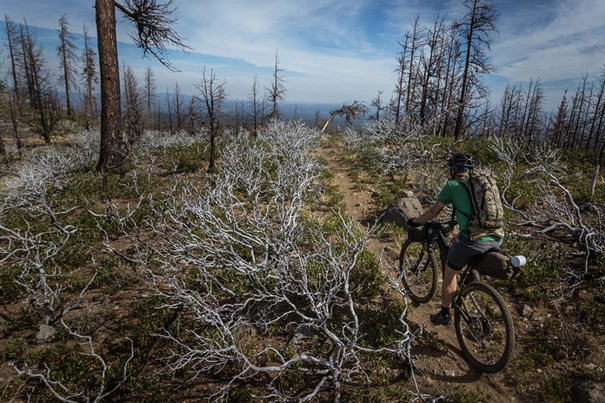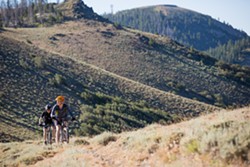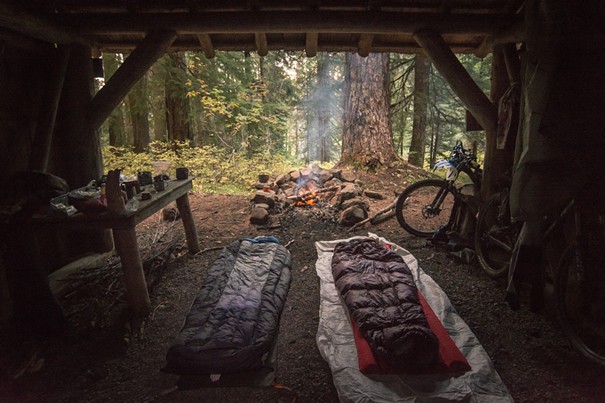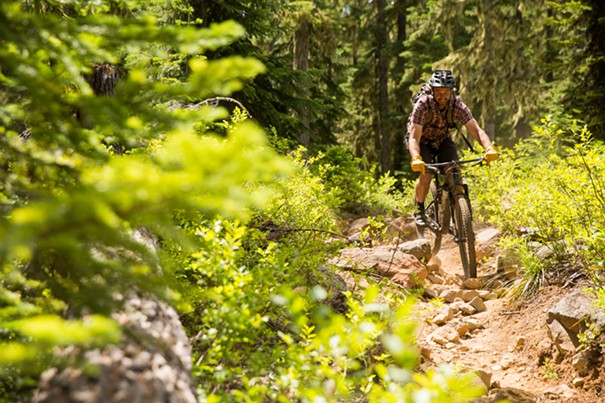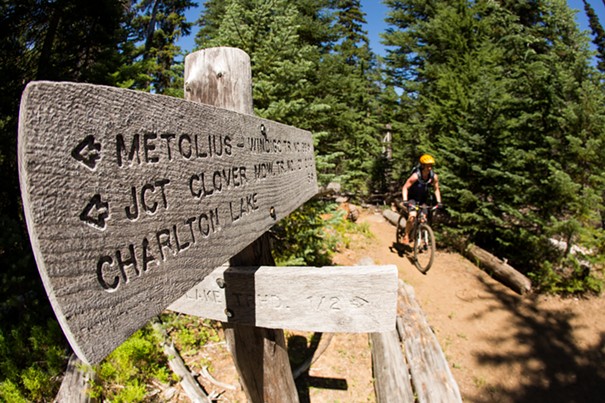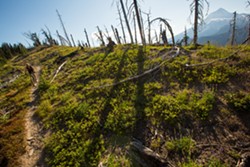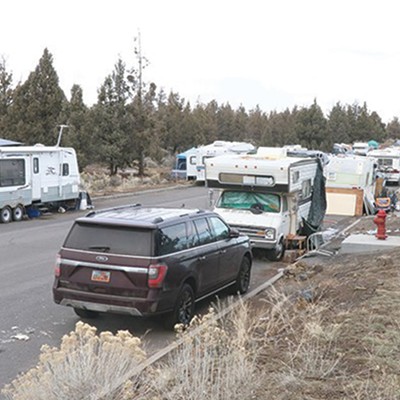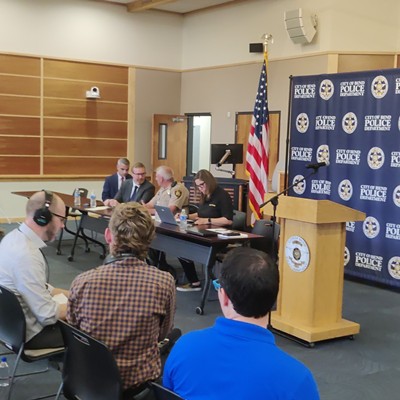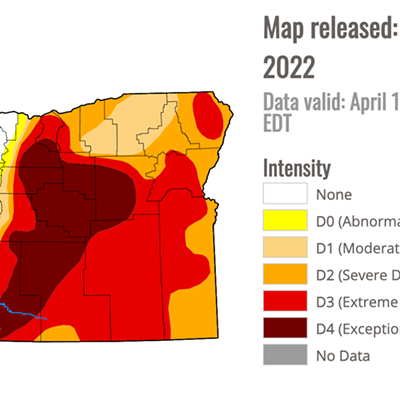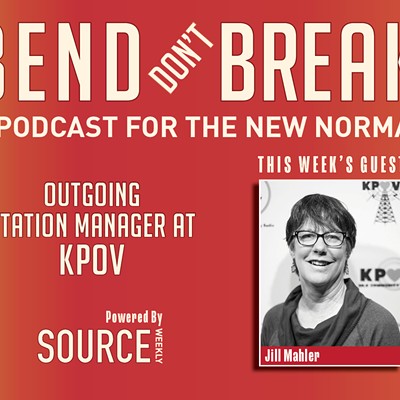The trail was soft and sandy, and we tried to catch our bearings on heavy, front-loaded mountain bikes. The first few miles we trudged over lava rocks with our heavy bikepacking rigs until we got into a rhythm. We carried dry bags and water bottles attached to cages on our forks, sleeping bags and pads on the handlebar set-up, and three days worth of food in our frame bags. In addition, 2-liter water bottles were mounted to our bottom bracket cages.
The weight of our mountain bikes felt foreign—swishing and wobbling—unsteady the first few miles on Swamp Wells Trail. The next day, we climbed along a thin line out of the mist and continued above the tree line. We spent most of the morning hiking and pushing our bikes over frequent blow down for 5 miles—the dreaded hike-a-bike. The traverse was becoming frustratingly slow.
Soon, the trail disappeared completely and we were on top of a flattened peak of open red sand with just a few sparse pines suspended in the cold. As we crossed the barren flat, the white diamond blazes revealed our invisible path to the other side of the low overhanging fog, connecting the dots. It was like we had entered another world entirely as we reached the rim of Newberry Crater. On mountain bikes, we were able to experience the crater from a viewpoint that many hikers coming from Paulina or East Lake do not. It's just far enough from Bend that even most mountain bikers don't reach the rim in a day ride—but we were on a bikepacking trip, all our gear ready to camp for several weeks.
Bikepacking is a form of travel, often in the backcountry, involving carrying a loaded bike. The ultimate goal of bikepacking, versus that of bicycle touring, is getting off the pavement in order to explore remote locations and a variety of terrain. Bend local John Krolak's favorite bikepacking destination is to the obsidian flow to the south of Newberry Crater. An employee of Fatback Bikes, Krolak says, "Its great to be able to get away from busy places, choose your company, and see interesting places that most people do not see."
I first started bikepacking about 10 years ago without even knowing it had a name different than "bike-touring." I had no money to buy a rack or pannier for my bike, so I strapped bags to my frame and handlebars. My friend's cabin was so remote that I couldn't reach it without riding on dirt roads. I loved riding the unpaved route so much that I gave up traditional bicycle touring and began searching for dirt trips off the beaten path. Bikepackers seem to appreciate the experience of being on trail, the ability to cross over ecotones—any transitional area between terrains and cultures. Gabriel Tiller, founder of Limberlost and the new Oregon Timber Trail Alliance (OTTA) tells me he appreciates the freedom of a rugged mountain bike that can traverse landscapes. "Bikepacking instills a sense of wonder that is rare in this world. It covers long distances and one is able to see the natural transitions between climates."
The online bikepacking community shares valuable information and publishes free route guides and GPS data on various websites such as Bikepacking.com, Bikepacking.net, and Oregon Bikepacking. Many of the routes link together existing trails with unpaved roads, and the combinations for successful trips are endless. Very few bikepacking routes are established, however, unlike the Pacific Crest Trail (PCT) or other National Scenic Trail thru-trail systems, many of which are closed to mountain bikers.
Tiller, inspired by established thru-hiking routes and community involvement, organized the founding of the Oregon Timber Trail Alliance. "At the core of it all for me, personally, is the desire to share Oregon's fantastic landscapes and wild places. If we can showcase the beauty of this state, we can instill in people an appreciation of what makes Oregon special and a desire to protect it. This is why I founded Limberlost (as well)."
The Oregon Timber Trail is a challenging 20-30- day route that traverses the Oregon Cascades from Modoc Mines on the California border to Hood River on the Columbia River Gorge. The entire route is more than 90 percent unpaved, with more than 50 percent of the route on pre-existing multi-use trails. It's remote and provides a bikepacker with a deep connection to the Cascade wilderness and the beauty the Oregon Cascades has to offer. The OTTA has developed a rich online resource, splitting the route and maps into four tiers (Fremont, Willamette, Deschutes, and Hood); manageable sections that can be ridden one at a time to provide greater accessibility.
Tiller's commitment to environmental stewardship, community, conservation and education make the ambitious project unique. The OTTA is pursuing and training certified sawyers, trail maintenance crews and other volunteers.
The route launch was last month in Portland, and it has a long way to go before the trails that make the route are in good condition. "Unfortunately, the OTT isn't a great route, yet, for people who are new to bikepacking. Much of the route is still in a primitive state and requires many volunteer hours to rehabilitate," Tiller says. Most of the groundwork for trail maintenance will take place in 2017 and 2018. They hope to make the OTT official with trailheads and signs by 2020.
Besides the Oregon Timber Trail, several other long-distance routes are within reach in Central Oregon. The Oregon Outback and Three Sisters, Three Rivers routes are two great examples. The region's multitude of trails and public land allow for endless weekend bikepacking options as well. Leave from Phil's Trailhead or Shevlin Park and connect several days worth of riding by carrying your belongings and sleeping outside.
Courtney Ley from Concord, N.H. and her friend Sue Lee from Weathersfield, V.T. flew here last summer to bikepack The Three Sisters, Three Rivers route that crosses the Cascades from Bend to Oakridge. "What really drew me to bikepacking in Oregon was how far someone can travel on a mountain bike exclusively on dirt," Ley says. "Back east, there's plenty of good mountain biking, but the trails are confined to small areas. In Oregon, we were able to travel 300 miles through a huge variety of environments and landscapes all on singletrack from downtown Bend."
My own first weekender from Bend was pure freedom. I rode fast and far the first day on smooth trails. I left my house, pedaled to Phil's Trailhead then headed west toward Tumalo Falls, Mt. Bachelor and to the Cascade Lakes. I had planned to go 25 miles of single track, but I went nearly 40 before I decided to stop for the day. I biked up and over the mountains from packed, dry powdery soil, juniper and sage to the forests where pine needles collected, decomposed and created spongy, moist ground. Then I meandered up and over the first ridge and descended to the lakes. At day's end, I sat in silence eating my meal amongst the trees, listening to the creek. I spent the entire weekend riding and camping. The last day, I smoothly descended the Mrazek trail and back to town. If I had more time, I could have continued riding trails looping throughout the Lake Region for weeks.
Bikepackers are able to experience the valuable connections between culture and nature. The bike is an efficient form of travel. A bikepacker can easily bike through a small town for a cup of coffee and groceries, then camp deep in the woods on the same day. Tiller reminds us, "When you're traveling by bike you see more than if you were cruising at 65 miles per hour, but also more diversity of landscape than if you were backpacking. Traveling by bike is the best way to bridge the divide between urban, rural, and wild lands."
Grab your bike, pack light, and head out to your favorite trail—then keep going. Explore the trails at oregontimbertrail.com
Alex Borgen is a writer and interdisciplinary artist living in Bend. She is heading to the Missoula Art Museum in June to lead an eco-art bikepacking trip as part of the By the Bike exhibition. Find her on Instagram @alex.borgen or alexborgen.com.
Explore the trails at oregontimbertrail.org
What do you need to start bikepacking?
If you have a mountain bike, a sleeping bag and a desire for self-supported adventures, you can bikepack. As long as you practice Leave No Trace principles, you can camp along much of Oregon's National Forest or BLM lands.
The route, your style of riding, and how much money you want to invest in the sport will determine how to begin loading your bike. Most of the new bags use rack-less mounting systems or minimal, specially designed systems, but can be expensive to try out for your first trip. It's not necessary to have well-designed, manufactured luggage to go out on your bike and sleep in the forest. Getting started can be as easy as lashing or tying things to your frame or rack. Borrow some bike luggage and try an overnighter. If you're ambitious, you can try sewing your own bags. These options allow you to try bikepacking without a hefty investment. If you want to spend some money, you can buy well-designed luggage from a variety of small companies, as well. Here are the basic luggage pieces for an awesome set-up:
Mountain bike and basic tools, in case of mechanical issues
Seat or saddlebag
Frame bag (if you can only afford one piece of luggage, this is my favorite)
Handlebar roll (the easiest DIY luggage option)
Small clutch that straps on the top for easy access items
Water bottle cages and bottles
Large cages (such as the Salsa Everything Cage or Blackburn Designs Many Thing Cage)
Camping set-up (sleeping bag, pad, shelter and dry bags)
Editors Note: This article has been amended from the print version to reflect the fact that the maps have not yet been revealed.

